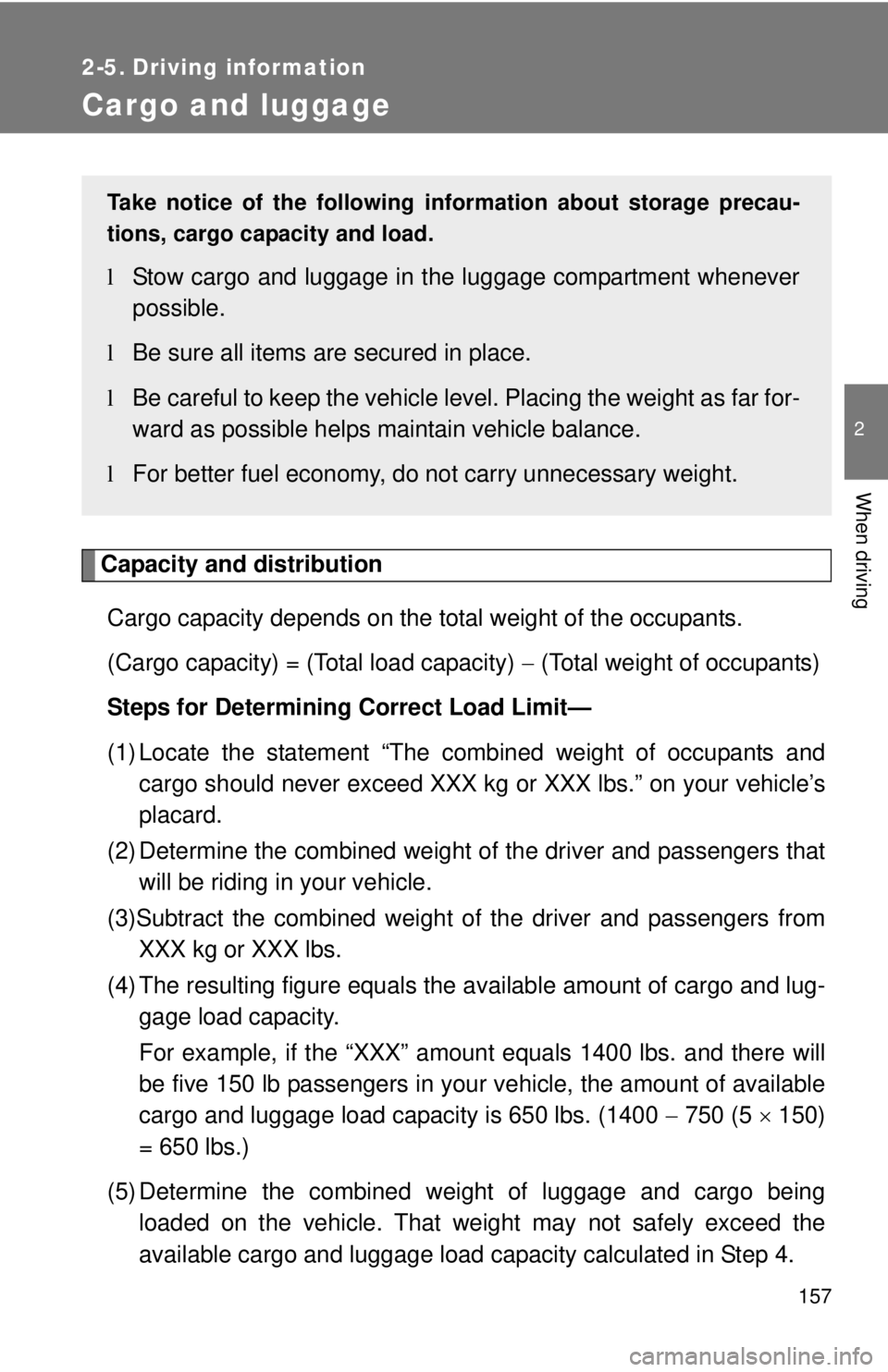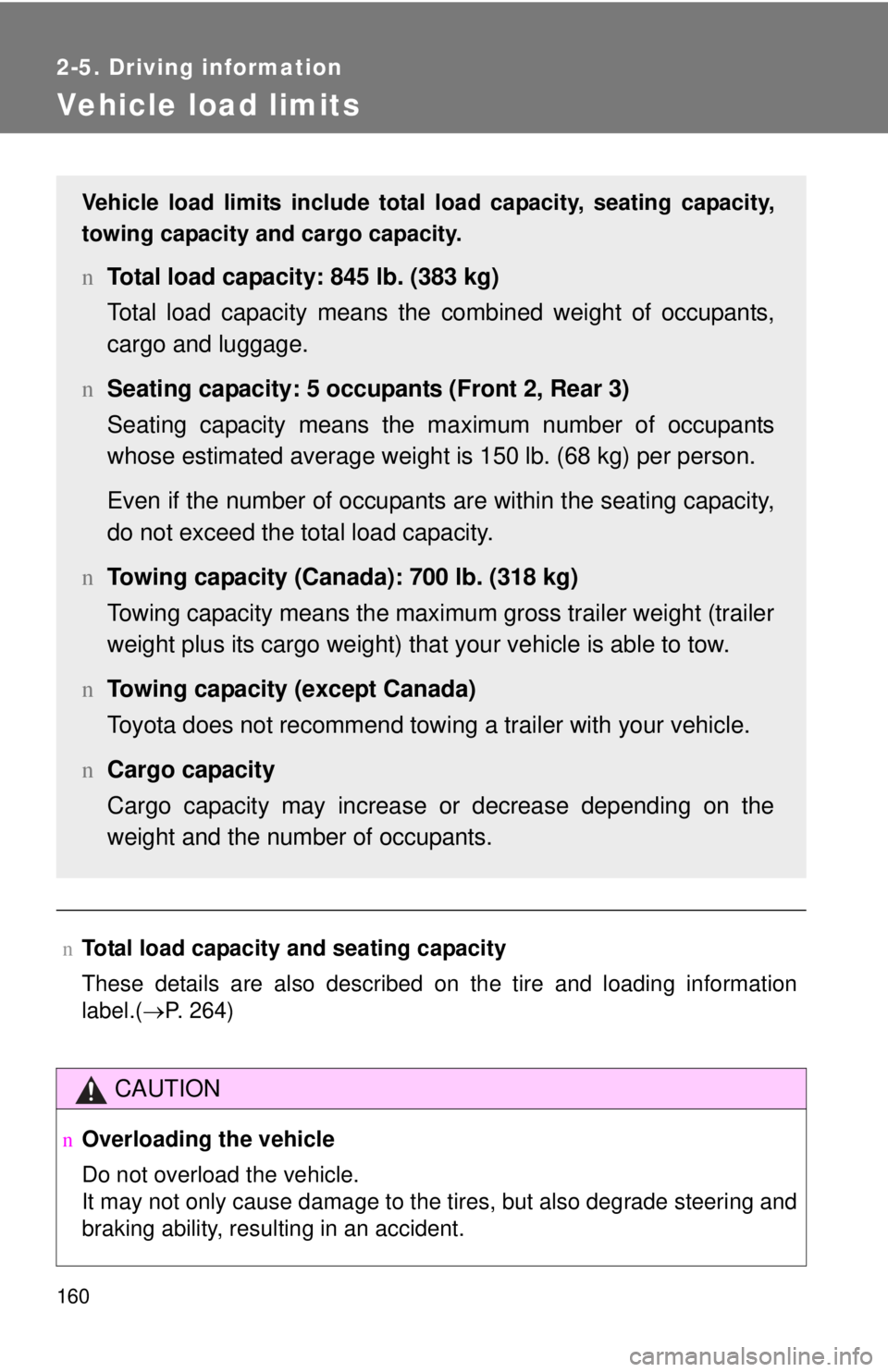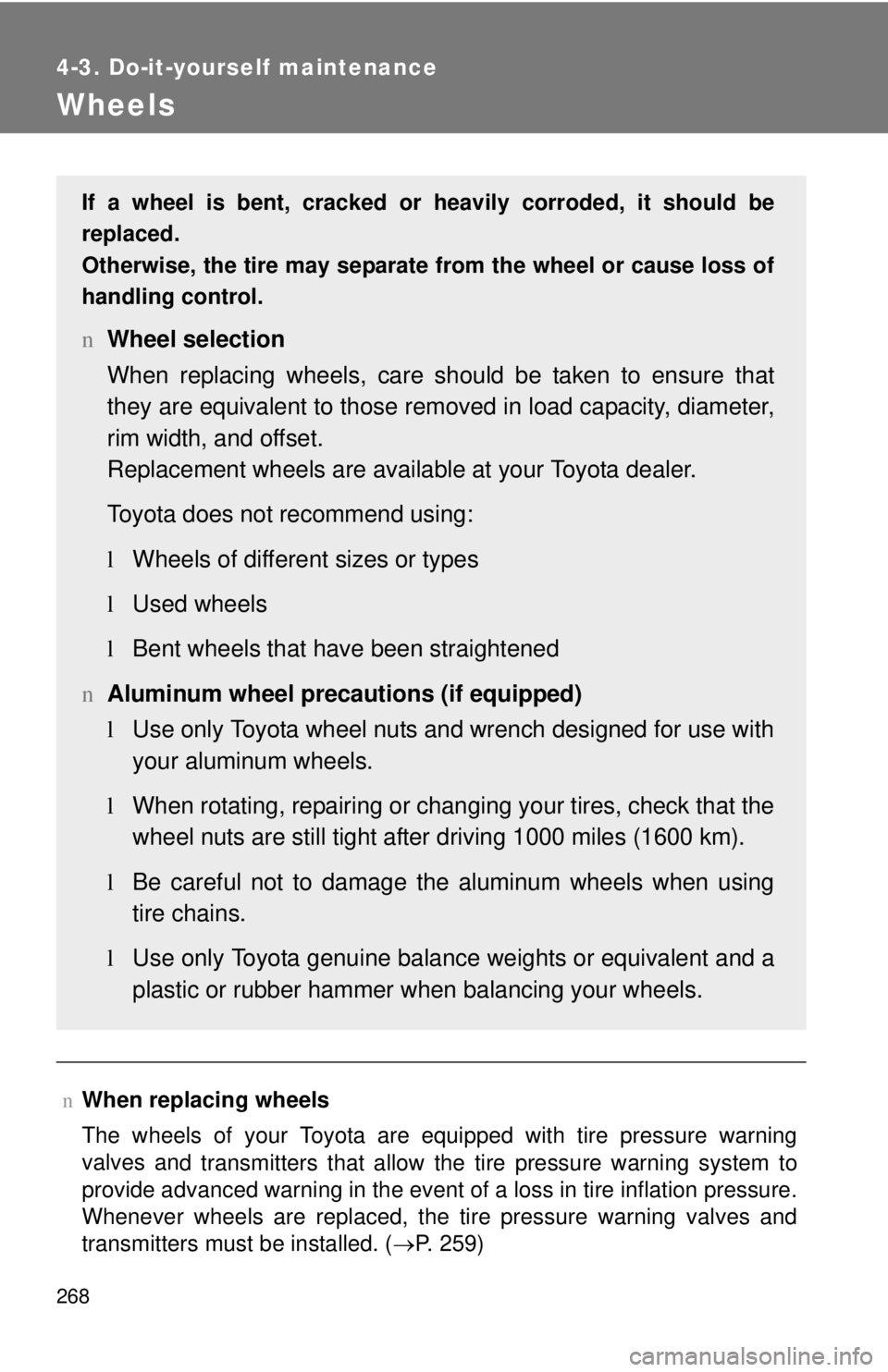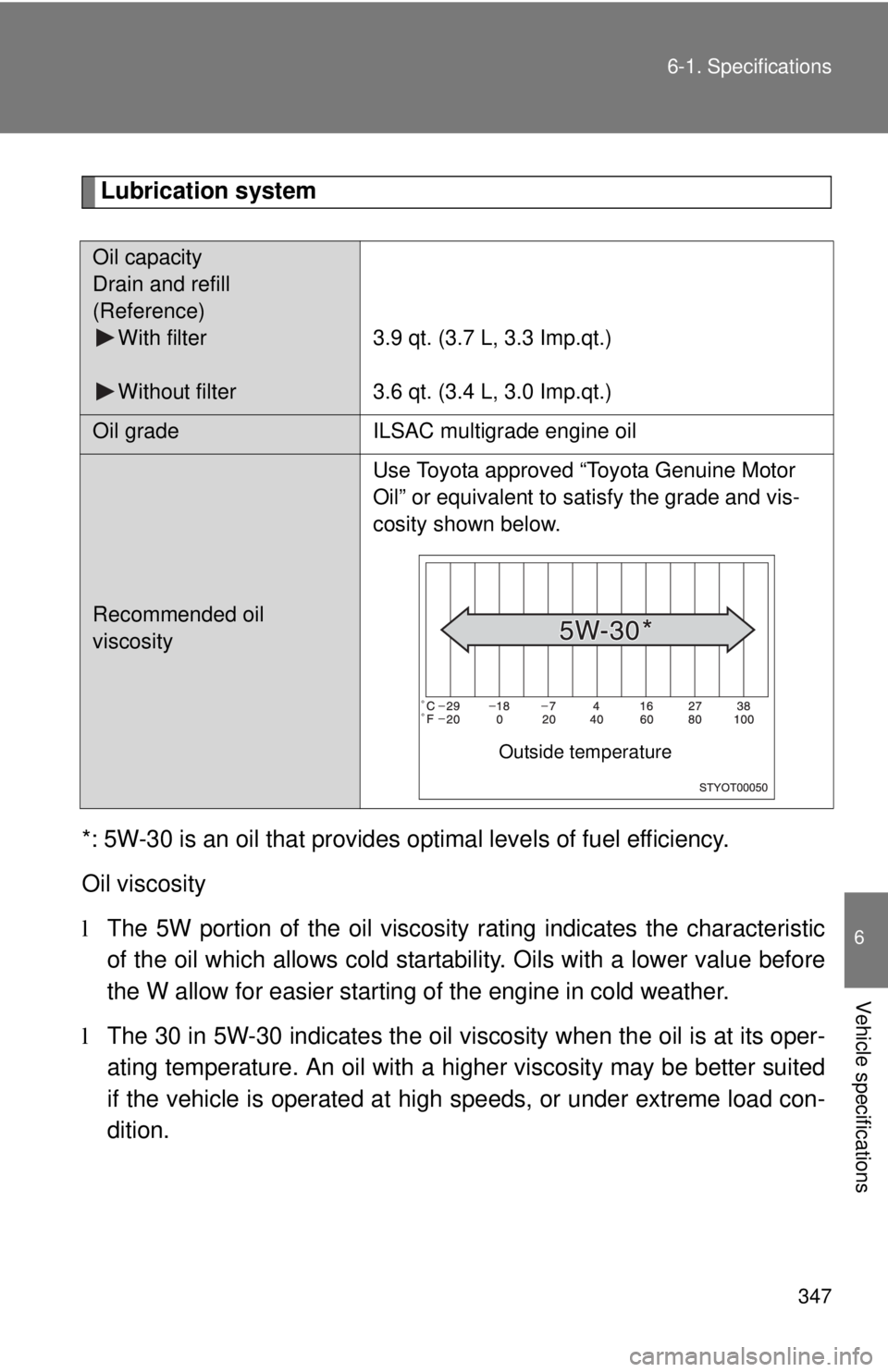2009 TOYOTA YARIS HATCHBACK load capacity
[x] Cancel search: load capacityPage 169 of 402

156 2-4. Using other driving systems
CAUTION
nThe ABS does not operate effectively when
lTires with inadequate gripping ability are used (such as excessively worn
tires on a snow covered road).
l The vehicle hydroplanes while driving at high speed on the wet or slick
road.
n Stopping distance when the ABS is ope rating on the wet or slick roads
The ABS is not designed to shorten the vehicle's stopping distance. Always
maintain a safe distance from the vehicle in front of you in the following situ-
ations.
l When driving on dirt, gravel or snow-covered roads
l When driving with tire chains
l When driving over bumps in the road
l When driving over roads with potholes or uneven roads
n Replacing tires
Make sure that all tires are of the same size, brand, tread pattern and total
load capacity. In addition, make sure that the tires are inflated to the appro-
priate tire pressure level.
The ABS will not function correctly if different tires are fitted on the vehicle.
Contact your Toyota dealer for further information when replacing tires or
wheels.
n Handling of tires and suspension
Using tires with any kind of problem or modifying the suspension will affect
the driving assist systems, and may cause the system to malfunction.
Page 170 of 402

157
2
When driving
2-5. Driving information
Cargo and luggage
Capacity and distribution
Cargo capacity depends on the total weight of the occupants.
(Cargo capacity) = (Total load capacity) − (T
otal weight of occupants)
Steps for Determining Correct Load Limit—
(1) Locate the statement “The combined
weight of occupants and
cargo should never exceed XXX kg or XXX lbs.” on your vehicle’s
placard.
(2) Determine the combined weight of the driver and passengers that will be riding
in your vehicle.
(3)Subtract the combined weight of the driver and passengers from XXX
kg or XXX lbs.
(4) The resulting figure equals the available amount of cargo and lug -
gage load capacity.
For example, if the “XXX” amount equals 1400 lbs. and there will
be
five 150 lb passengers in your vehicle, the amount of available
cargo and luggage load capacity is 650 lbs. (1400 − 750 (5 × 150)
= 650 lbs.)
(5) Determine the combined weight of luggage and cargo being loaded on the vehicle. That weight may not safely exceed the
available cargo and luggage load capacity calculated in Step 4.
Take notice of the following information about storage precau-
tions, cargo capacity and load.
l Stow cargo and luggage in the luggage compartment whenever
possible.
l Be
sure all items are secured in place.
lBe
careful to keep the vehicle level. Placing the weight as far for -
ward as possible helps maintain vehicle balance.
l For better fuel eco
nomy, do not carry unnecessary weight.
Page 171 of 402

158 2-5. Driving information
(6) If your vehicle will be towing a trailer, load from your trailer will be
transferred to your vehicle. Consult this manual to determine how
this reduces the available cargo and luggage load capacity of your
vehicle.
Except Canada:
Toyota does not recommend towing a trailer with your vehicle. Your
vehicle is not desig
ned for trailer towing.
Example on your vehicle
Cargo capacity
Total load capacity
When 2 people with the combined weight of 366 lb. (166 kg) are
riding
in your vehicle, which has a total load capacity of 845 lb. (383
kg), the available amount of cargo and luggage load capacity will be
as follows:
845 lb. − 366 lb.
= 479 lb. (383 kg − 166 kg = 217 kg)
In this condition, if 3 more pass engers with the combined weight of
388 lb. (176 kg) get on , the available cargo and luggage load will be
reduced as follows:
479 lb. − 388 lb. = 91 lb. (217 kg − 176 kg = 41 kg)
As shown in the above example, if th
e number of occupants
increases, the cargo and luggage lo ad will be reduced by an amount
that equals the increased weight du e to the additional occupants. In
other words, if an increase in the number of occupants causes an
excess of the total load capacity (combined weight of occupants plus
cargo and luggage load), you must reduce the cargo and luggage on
your vehicle.
Page 172 of 402

159
2-5. Driving information
2
When driving
CAUTION
nThings that must not be carried in the luggage compartment
The following things may cause a fire if loaded in the luggage compart-
ment.
lReceptacles containing gasoline
lAerosol cans
nStorage precautions
lDo not place anything on the luggage cover, and do not stack anything
in the luggage compartment higher than the seatbacks.
Such items may be thrown about and possibly injure people in the
vehicle during sudden braking or in an accident.
lDo not drive with objects on top of the instrument panel.
They may interfere with the driver’s field of view or move during sharp
acceleration or turning, thus impairing the driver’s control of the vehi-
cle. In an accident they may injure the vehicle occupants.
lSecure all items in the occupant compartment, as they may shift and
injure someone during an accident or sudden braking.
lNever allow anyone to ride in the luggage compartment. It is not
designed for passengers. They should ride in their seats with their seat
belts properly fastened. Otherwise, th ey are much more likely to suffer
serious bodily injury, in the even t of sudden braking or a collision.
nCapacity and distribution
lDo not exceed the maximum axle weight rating or the total vehicle
weight rating.
lEven if the total load of occupant’s weight and the cargo load is less
than the total load capacity, do no t apply the load unevenly. Improper
loading may cause deterioration of st eering or braking control which
may cause death or serious injury.
Page 173 of 402

160
2-5. Driving information
Vehicle load limits
nTotal load capacity and seating capacity
These details are also described on the tire and loading information
label.(→P. 2 6 4
)
CAUTION
nOverloading the vehicle
Do not overload the vehicle.
It may not only cause damage to the ti res, but also degrade steering and
braking ability, resulting in an accident.
Vehicle load limits include total load capacity, seating capacity,
towing capacity and cargo capacity.
n Total load capacity: 845 lb. (383 kg)
Total load capacity means the combined weight of occupants,
car
go and luggage.
n Se
ating capacity: 5 occupants (Front 2, Rear 3)
Seating capacity means the ma ximum n
umber of occupants
whose estimated average weight is 150 lb. (68 kg) per person.
Even if the number of occupants are within the seating capacity,
do no
t exceed the total load capacity.
n T
owing capacity (Canada): 700 lb. (318 kg)
Towing capacity means the maximum gross trailer weight (trailer
weigh
t plus its cargo weight) that your vehicle is able to tow.
n T
owing capacity (except Canada)
Toyota does not recommend towing a trailer with your vehicle.
n Cargo cap
acity
Cargo capacity may increase or decrease depending on the
weigh
t and the number of occupants.
Page 271 of 402

260 4-3. Do-it-yourself maintenance
nIf the tread wears down below 0.16 in. (4 mm) on snow tires
The effectiveness of snow tires is lost.
nMaximum load of tire
Check that the maximum load of the replaced tire is greater than 1/2 of
the Gross Axle Weight Ratings (GAWR) of either the front axle or the
rear axle, whichever is greater.
As for the maximum load of the tire, see the load limit at maximum cold
tire inflation pressure mentioned on the sidewall of the tire, and as for the
Gross Axle Weight Ratings (GAWR) , see the Certification Label. (→P.
264, 356).
nTire types
1 Summer tires
Summer tires are high-speed performance tires best suited to highway
driving under dry conditions. Since summer tires do not have the same
traction performance as snow tire s, summer tires are inadequate for
driving on snow-covered or icy roads. For driving on snow-covered
roads or icy roads, the use of snow tires is recommended. When
installing snow tires, be sure to replace all four tires.
2 All season tires
All season tires are designed to provide better traction in snow and to
be adequate for driving in most winter conditions, as well as for use
year round. All season tires, however, do not have adequate traction
performance compared with snow tires in heavy or loose snow. Also,
all season tires fall short in acceleration and handling performance
compared with summer tires in highway driving.
3Snow tires For driving on snow-covered roads or icy roads, we recommend using
snow tires. If you need snow tires, select tires of the same size, con-
struction and load capacity as the or iginally installed tires. Since your
vehicle has radial tires as original equipment, make sure your snow
tires also have radial construction. Do not install studded tires without
first checking local regulations for possible restriction. Snow tires
should be installed on all wheels. ( →P. 161)
Page 279 of 402

268
4-3. Do-it-yourself maintenance
Wheels
nWhen replacing wheels
The wheels of your Toyota are equipped with tire pressure warning
valves an
d transmitters that allow the tire pressure warning system to
provide advanced warning in the event of a loss in tire inflation pressure.
Whenever wheels are replaced, the tire pressure warning valves and
transmitters must be installed. ( →P. 2 5 9 )
If a wheel is bent, cracked or heavily corroded, it should be
replaced.
Otherwise, the tire may separate from the wheel or cause loss of
ha
ndling control.
nWheel selection
When replacing wheels, care shou ld
be taken to ensure that
they are equivalent to those removed in load capacity, diameter,
rim width, and offset.
Replacement wheels are available at your Toyota dealer.
Toyota does not recommend using:
l Whee
ls of different sizes or types
lUs
ed wheels
lBe
nt wheels that have been straightened
n Aluminum wheel precau
tions (if equipped)
l Use only
Toyota wheel nuts and wrench designed for use with
your aluminum wheels.
l When
rotating, repairing or changing your tires, check that the
wheel nuts are still tight after driving 1000 miles (1600 km).
l Be
careful not to damage the aluminum wheels when using
tire chains.
l Use only T
oyota genuine balance weights or equivalent and a
plastic or rubber hammer when balancing your wheels.
Page 356 of 402

347
6-1. Specifications
6
Vehicle specifications
Lubrication system
*: 5W-30 is an oil that provides
optimal levels of fuel efficiency.
Oil viscosity
l The
5W portion of the oil viscosity rating indicates the characteristic
of the oil which allows cold startability. Oils with a lower value before
the W allow for easier starting of the engine in cold weather.
l The 30 in 5W
-30 indicates the oil viscosity when the oil is at its oper -
ating temperature. An oil with a higher viscosity may be better suited
if
the vehicle is operated at high speeds, or under extreme load con -
dition.
Oil capacity
Drain and refill
(Reference) With filter
Without filter
3.9 qt. (3.7 L, 3.3 Imp.qt.)
3.6 qt. (3.4 L, 3.0 Imp.qt.)
Oil grade
ILSAC multigrade engine oil
Recommended oil
viscosity Use Toyota approved “Toyota Genuine Motor
Oil” or equivalent to satisfy the grade and vis-
cosity shown below.
Outside temperature